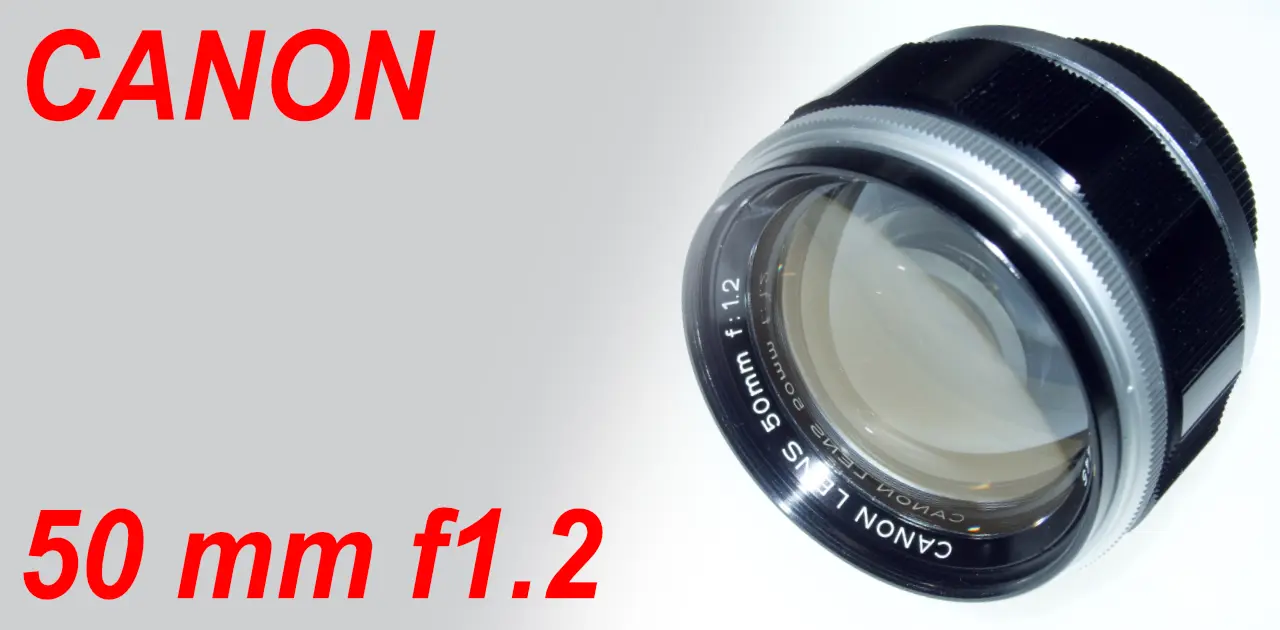A review and sample photos of the Canon L39 screw mount 50mm f/1.2 lens used with the Leica M8.2.
- Please see the disclaimer regarding advertising here.
- Italicized links in the text are advertisement links that take you to other sites.
Table of contents
Photo example
The following cameras were used to take the sample photos:
- LEICA M9
- LEICA M6TTL +KODAK XL100 ネガフィルム
Review
1.Overview
The CANON S 50mm f/1.2 is a standard lens with an L39 screw mount, released by Canon in 1956 for their Barnack Leica-compatible cameras. Canon calls it the S-mount, taking the initials of the screw.
Main specifications are as follows, with details listed in the table.
- Aperture: F1.2
- Lens Construction: 6 elements in 4 groups
- Aperture Blades: 10
- Minimum Focus: 1.0m
- Leica M Rangefinder Camera Rangefinder Coupling: 1.0m
- Hood: Dedicated screw-on hood
2.Usability
The CANON S 50mm f/1.2 is the flagship lens of Canon’s S lens (L39 mount), which reached its peak in 1956-1957. Before its price revision, it had a higher list price than Canon’s largest-aperture lens, the 50mm f/0.95.
The lens’s large diameter barrel clearly reflects its design intent of capturing more light on the film surface, and the smooth focus ring and precise infinity lock are well-crafted.
The lens’s image quality is low at full aperture, and the thin focal plane makes the image appear soft when slightly off-focus. Furthermore, as is common with older lenses, the foreground and background bokeh are not particularly beautiful.
Stopping down the aperture improves overall image resolution and improves the softness of the image. However, the bokeh remains somewhat lackluster.
Some say that if you want to use it at a narrow aperture, you should use a 50mm f/1.4 or 50mm f/2, so if you’re going to take this big, thick lens with you, you’ll want to learn how to use it wide open.
When attached to an M-series Leica, whether film or digital, the lens’s thick barrel intrudes into the viewfinder, blocking it and getting in the way when you take a picture.
However, with a mirrorless camera, you view the image through an electronic viewfinder, so there’s no problem of it getting in the way when looking through the viewfinder.
Also, with a rangefinder camera, you have to practice adjusting the focus to get it where you want it, but fortunately with the EVF on a mirrorless camera, you don’t have to worry about the focus position, so you can use the lens with peace of mind.
The lens barrel has an infinity lock, but the focus ring on the one I owned had just the right amount of weight, and it didn’t shift position on its own even without the lock, so there’s no practical use for this lock. However, the click sound when you return it to infinity is a nice accent to the lens. However, it was a hassle to have to unlock the focus ring every time I moved it.
3.Summary
In conclusion, to sum up the CANON S 50mm F1.2 is a lens that is at the top of Canon’s standard rangefinder lenses for normal use. Unlike modern large-aperture lenses, it is interesting to incorporate the changes in depiction as you stop down from wide open aperture into your work. However, there are subtleties in depiction, so you won’t know whether it suits your preferences until you try it.
Specifications, considerations, etc.
The Canon S 50mm F1.2 is the flagship lens of the Canon S lens (L39 mount), which reached its peak in 1956-1957.
It has nearly the same optical design as the later-released 50mm F0.95, but its slower maximum aperture makes it more compact. Still, it weighs about twice as much as the 50mm F1.4, which is half a stop slower, giving it the presence of a large-aperture lens.
In the “Summary” section, I mentioned that image quality changes when the aperture is stopped down from maximum aperture, but modern lenses are designed to minimize this change in image quality when stopped down from maximum aperture. Another lens that exhibits a similar change is the Ms-Optics 50mm lens.
A Gaussian lens with the same design as this lens is the MS-ISM 50mm F1.0, and a Sonnar-type lens is the MS-SONNETAR 50mm F1.1.
The lens construction diagram published in my book, Leica Lenses of the World Part 1 (p. 124)/CANON 50mm F1.2, shows the rearmost lens element with the largest diameter, similar to Nikon’s 35mm F1.8, which I believe is a mistake in the lens construction diagram. I haven’t checked, but it may have been corrected in later editions.
The diagram on the page, A list of vintage super-fast 50-60mm f/1.2 lenses, shows the rear lens element smaller than the front lens element, which seems to be a reasonable diagram.
| Items | CANON | MS-ISM |
| Focal length(mm) | 50 | 50 |
| Max aperture | 1.2 | 1.1 |
| Min aperture | 22 | 16 |
| Leaf blade | 11 | 16 |
| Lens Construction | 7elements in 5groups | 7elements in 5groups |
| Min distance(m) | 1.0 | 0.8 |
| Lens length(mm) | 39 | 41 |
| Max diameter(mm) | 63 | 54.7 |
| Filter Size(mm) | 55 | 55 |
| Weight(g) | 322 | 178 |
| Lens mount | L39 | M |
| Release date | 1956.09 | 2019.08 |
| Price(Yen/No-tax) | ¥60,000- | ¥150,000- |
Reference links
- Canon Museum 50mm F1.2
- Leica lenses from around the world Part 1 (P124)/CANON 50mm F1.2・amazon affiliate link
- A list of vintage super-fast 50-60mm f/1.2 lenses
- MS-SONNETAR 50mm F1.1・Shige’s hobby
- MS-ISM 50mm F1.0 GA・Shige’s hobby
Affiliate links
- Amazon Affiliate Link/ Keyword=Canon Lens
- Amazon Affiliate Link/ Keyword=Old canon books
- Amazon Affiliate Link / Keyword=CANON L-Mount lens

Amazon Prime Sale
Update history
- 2025.9.10



Be First to Comment